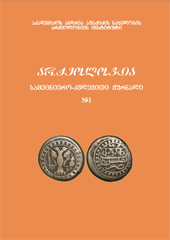The Origin and Content of the Emblem of the European University’s Academitian Andria Apakidze Archaeological Institute
Keywords:
Archeology, Svetitskhoveli, Antefix, Emblem, SymbolAbstract
The article explores the origin and features of the antefix discovered near the Svetitskhoveli Cathedral in Mtskheta, which served as the inspiration for the “Logo” of the European University’s Acad. Andria Apakidze Archaeological Institute.
For over 2000 year, Patriarchate of Georgian has carried out intensive work in the courtyard of Svetitskhovli and its surrounding area in order to embellish it. The Mtskheta Institute of Archaeology was obliged to supervise the works in order to describe and record each discovery point.
The Mtskheta Institute of Archaeology (Head: Acad. Andria Apakidze) traced the clay antefix to the west of the Svetitskhovli temple, five meters away from it. The antefix is embossed and molded, featuring a “Tree of Life” on a pedestal. It’s lower branches are adorned with “pomegranates”, and it is crowned with a three-pronged tip. Below it, there is the transverse arms of the cross. The “Tree of Life” motifs are common across the East, but this particular version, with the cross-like arms, is typical of the late Hittite style. In reference to the situation discussed, we can think that the “Cross” on the Svetitskhoveli sample is not an addition, but a result of the transformation of the motif.
The antefix, depending on the content, is a noteworthy, with few known parallels. Despite the simplicity and brevity of the image, it contains a narrative text, informing us of the dialogue process between the “Tree of Life” and the “Cross”. In terms of dating, the antefix was created in the pre-Christian era, probably in the 4th century.
Downloads
Published
Issue
Section
License
Copyright (c) 2024 Archeologia

This work is licensed under a Creative Commons Attribution-ShareAlike 4.0 International License.




